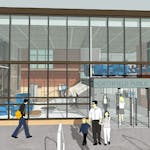In a corner of the West St. Paul Police Department women's bathroom, Shannon Mitchell and four other female officers dress and shove their belongings into their lockers.
Now, with another woman joining the department and barely any elbow room as it is, Chief Bud Shaver again will have to rearrange the makeshift locker room to accommodate his changing workforce. "The female locker room wasn't meant to be a locker room at all," Shaver said. "I put like five lockers in there, so it isn't much bigger than your master bathroom at home."
Suburban public safety departments, many of them stuck in aging facilities with cramped quarters, are scrambling to provide equal space for women cops even as the male-dominated police ranks become more diverse.
Minnesota is seeing an annual rise in the number of newly licensed female officers, going from about 46 in 2011 to 67 in 2014, according to the Minnesota Board of Peace Officer Standards and Training.
But departments often struggle to find space for them.
West St. Paul, for instance, is caught in a bind. With no funding to make much-needed changes to its headquarters, the department must make do with one locker room containing 20 lockers for its male officers and a bathroom with five lockers for the women.
Both areas have reached capacity, but Shaver estimates it could cost from $50,000 to $100,000 to expand.
"We don't have room for even the new hire to go in there," said Mitchell, a police investigator. "There really is no space for anyone to do anything in there or move around."
'Pretty maxed out'
Cindy A. McCleary, vice president of Leo A Daly, an architectural firm, is conducting a space study of the Oakdale Police Department. Municipal buildings nationally are in need of upgrades, and gender equity is one issue playing into that need, she said.
"More often than not, when facilities don't provide adequate gender equity in their spaces, they're also not providing other critical things that are impacting their operation, like insufficient evidence space," McCleary said. "There might not be enough showers, enough locker room space. Those tend to be very costly pieces of the building to be able to renovate. So oftentimes it's done comprehensively, with a fuller renovation."
Oakdale police Capt. Karin LaTour said she would give up her locker of 25 years to a fellow officer if the department hired another woman. All eight of the women's lockers are taken.
"Our goal is to give all female employees a locker so they could change before or after work," LaTour said. "We're pretty maxed out now."
Adaptable work spaces
Many public safety departments with newer or remodeled facilities have adapted to the changing workforce. The Owatonna Police Department included a lactation room for new moms in its renovation.
The Richfield Fire Department took gender into account when it moved into the city's municipal complex in 2011 and remodeled its second fire station. The city spent $23 million for the municipal center, including city hall, and about $1 million to remodel the other station.
Both stations originally were designed for firefighters to sleep in one room on bunk beds. At Station Two, a lieutenant decided to bunk with other male firefighters and give his room to a female firefighter.
The improvements boiled down to making sure facilities were equal for men and women, said Fire Chief Wayne Kewitsch. The department now has individual sleeping quarters. "Our workforce was changing, and we knew it was going to change," Kewitsch said. "Thirty years ago, it was 'fireman'; now it's 'firefighter.' "
Even in new facilities, the locker room space for women is often smaller than that for men. But departments are including room for expansion.
At the Richfield complex, the Fire Department built in a movable wall to increase space when more women are hired. And the police included a movable wall in the department's new locker room space; three years later, the wall has already moved. Of 45 sworn officers in Richfield, eight are women.
National Guard affected, too
Police and fire departments are not the only agencies looking at gender equity in their buildings.
More than half of the Minnesota National Guard's facilities have inadequate facilities for women, if any, said Larry Herke, the guard's construction and facilities management officer. At the West St. Paul armory, a sign posted outside the lone shower designates times for male and female use.
Jill Gaulding, co-founder and legal director of Gender Justice, a nonprofit law firm, has seen the topic of gender equity come up in academic departments, where women professors do not have separate bathrooms. Gaulding said traditionally male-dominated workplaces need to approach gender equity head-on.
"If the mentality is we will have fewer women officers, it speaks to a larger problem of how the department is envisioning itself," she said. "The police force should mirror the community in every aspect."
Beatrice Dupuy • 952-746-3281
![Captain Karin LaTour shows off the cramped women's locker room at the Oakdale Police Department. ] (Leila Navidi/Star Tribune) leila.navidi@startribun](https://arc.stimg.co/startribunemedia/S5GFRVNT2GJ7YLA3VR3N4XOE5E.jpg?fit=crop&crop=faces&w=550&&auto=format)



